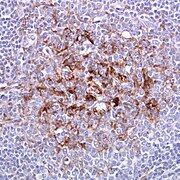Portal:Viruses/Selected article/17
Variant Creutzfeldt–Jakob disease, or vCJD, is a rare type of central nervous system disease within the transmissible spongiform encephalopathy family, caused by a prion. First identified in 1996, vCJD is now distinguished from classic CJD. The incubation period is believed to be years, possibly over 50 years. Prion protein can be detected in appendix and lymphoid tissue (pictured) up to two years before the onset of neurological symptoms, which include psychiatric problems, behavioural changes and painful sensations. Abnormal prion proteins build up as amyloid deposits in the brain, which acquires a characteristic spongiform appearance, with many round vacuoles in the cerebellum and cerebrum. The average life expectancy after symptoms start is 13 months.
About 170 cases have been recorded in the UK, and 50 cases in the rest of the world. The estimated prevalence in the UK is about 1 in 2000, higher than the reported cases. Transmission is believed to be mainly from consuming beef contaminated with the bovine spongiform encephalopathy prion, but may potentially also occur via blood products or contaminated surgical equipment. Infection is also believed to require a specific genetic susceptibility in the PRNP-encoding gene. Human PRNP protein can have either methionine or valine at position 129; nearly all of those affected had two copies of the methionine-containing form, found in 40% of Caucasians.
